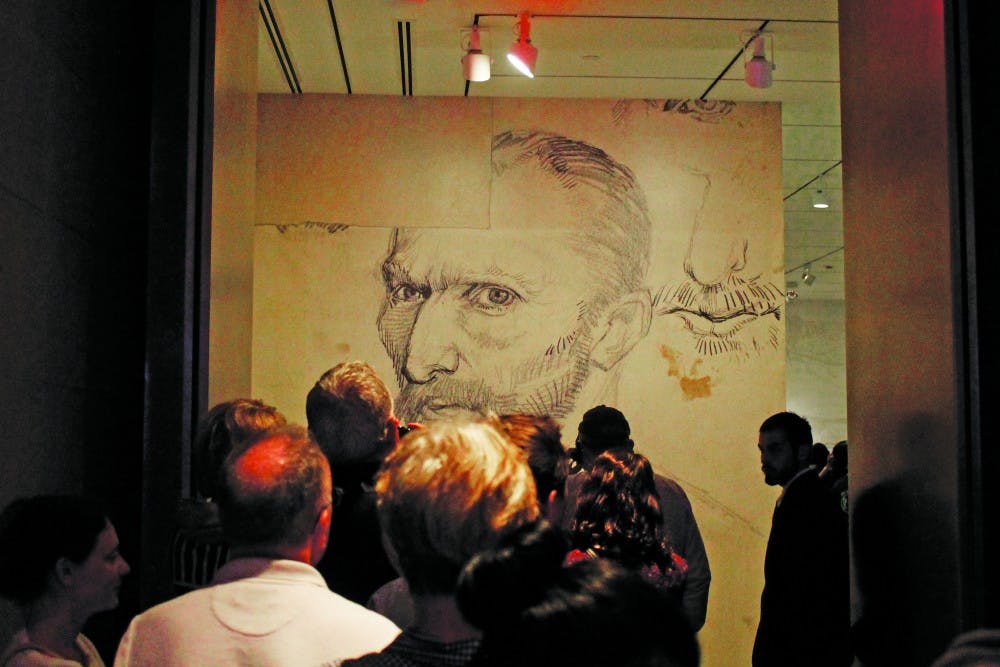Museum of Fine Arts’ ‘Vincent van Gogh: His Life in Art’ immerses viewers

Vincent van Gogh is arguably one of the most iconic artists of the 19th century, although his work wasn’t fully appreciated until after his death. The exhibition at the Museum of Fine Arts, Houston, which includes over 50 of Van Gogh’s works, presents five periods in his life: The Early Years, Paris, Arles, Saint Rémy and Auvers sur Oise. This showcase not only displays his unique style but also gives the audience insight into his sad, tumultuous life.
The MFAH goes beyond simply presenting Van Gogh’s masterpieces by including recreations and artifacts of his time. When entering the first room of the exhibit, museum-goers are greeted with a wall-sized portrait of the artist himself, evocative of the pencil sketches that composed his earlier works. On every wall, there are sketches of the French countryside where Van Gogh resided. These sketches create a backdrop each of the paintings, bringing life and continuity to his body of work. Visitors are also provided audio guides for the exhibit which supply sounds from periods in his life. When entering the final room of the showcase, audiences are met with a large reproduction of one of Van Gogh’s most notable works, “Wheatfield With Crows,” which was created the same year he died after struggling with epilepsy, mania and depression. This mural provides a poignant ending to the museum’s display, reminding viewers of the Dutch painter’s artistic talent and his tragic death by suicide.
While Van Gogh himself is no longer able to shed light on his personal life, the MFAH exhibit gives viewers insight into his mind by displaying some of the 820 letters he wrote to his younger brother Theo and other artists. Fragments of the correspondences are printed in huge font on the walls, flowing neatly around the works of art. Accompanying one of his first major works, “The Potato Eaters,” is a full length letter that Van Gogh wrote to Theo. In it, Van Gogh explains how he wants to depict the hardships of rural life in “uncompromising realism.” These letters reveal Van Gogh’s motivation behind some of his most recognizable pieces in addition to shedding light on his struggles as an artist.
Nowhere is more immersive than the MFAH’s companion display, “Van Gogh Up Close.” This exhibit is admittedly more catered to children, with interactive features and a chance to recreate Van Gogh’s famous work, “Sunflowers.” However, “Van Gogh Up Close” provides unique experiences for all museum-goers, recreating his most notable works with physical sets and providing a way for audiences to truly immerse themselves in Van Gogh’s art.
“Vincent Van Gogh: His Life in Art” gives visitors more than just a chance to view some of the most famous artworks of the 19th century. It provides audiences with a chance to understand the motivation behind some of Van Gogh’s most iconic pieces and his struggle with his mental health.
“Vincent Van Gogh: His Life in Art” runs until June 27. Admission is $20 for students with ID.
More from The Rice Thresher

Andrew Thomas Huang puts visuals and identity to song
Houston is welcoming the Grammy-nominated figure behind the music videos of Björk and FKA twigs on June 27.

Live it up this summer with these Houston shows
Staying in Houston this summer and wondering how to make the most of your time? Fortunately, you're in luck, there's no shortage of amazing shows and performances happening around the city. From live music to ballet and everything in between, here are some events coming up this month and next!

Review: 'Adults' couldn’t have matured better
Sitcoms are back, and they’re actually funny. FX’s “Adults” is an original comedy following a friend group navigating New York and what it means to be an “actual adult.” From ever-mounting medical bills to chaotic dinner parties, the group attempts to tackle this new stage of life together, only to be met with varying levels of success.

Please note All comments are eligible for publication by The Rice Thresher.